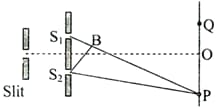In Young's double-slit experiment, the red light of wavelength is used and the bright fringe is obtained at a point on the screen. Keeping the same setting, the source of light is replaced by the green light of wavelength and now bright fringe is obtained at the point on the screen. The value of is

Important Questions on Interference and Diffraction
In Young's double-slit experiment, if the distance between two slits is equal to the wavelength of used light. Then the maximum number of bright fringes obtained on the screen will be
A mixture of light consisting of wavelength and an unknown wavelength illuminates Young's double-slit and gives rise to two overlapping interference patterns on the screen. The central maximum of both lights coincide. Further, it is observed that the third bright fringe of known light coincides with the bright fringe of the unknown light. From this data, the wavelength of the unknown light is
The monochromatic green light of wavelength illuminates a pair of slits apart. The separation of bright lines on the interference pattern formed on a screen away is
In the figure is shown Young's double-slit experiment. is the position of the first bright fringe on the right side of . is the fringe on the other side, as measured from . If the wavelength of the light used is , then will be equal to

Two coherent sources and produce interference at a point on the screen where there is a dark band which is formed between bright band and bright band. The wavelength of light used is . The path difference between and is
A beam of light of from a distant source falls on a single slit wide and the resulting diffraction pattern is observed on a screen away. The distance between the first dark fringes on either side of the central bright fringe is
A fringe width of a certain interference pattern is . What is the distance of order minima from central maxima?
Two slits separated by a distance of are illuminated with light of wavelength . The interference fringes are observed on a screen placed from the slits. The distance between the fourth dark and sixth bright fringe on the same side is equal to
